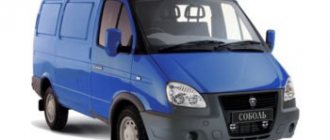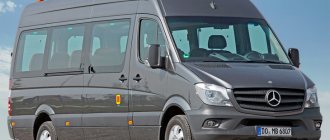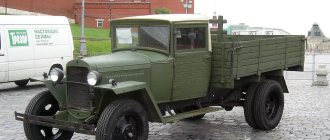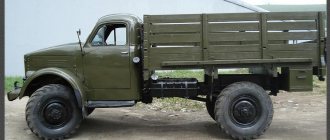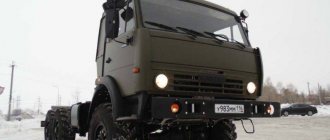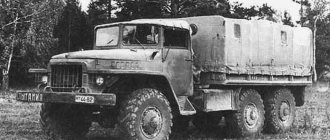Depreciation groups of vehicles
Motor vehicles, in accordance with the Classification of fixed assets, are classified into III-V depreciation groups. Let us recall that the SPI for them is set as follows:
- III – over 3 to 5 years inclusive;
- IV - over 5 to 7 years inclusive;
- V - over 7 to 10 years inclusive.
Here are examples of vehicles classified in these groups:
| Depreciation group | Name of the vehicle |
| III | Passenger cars (with an engine capacity of no more than 3.5 liters); Buses are especially small and small, up to 7.5 m long inclusive; Trucks with a diesel or gasoline engine, having a technically permissible maximum weight of not more than 3.5 tons |
| IV | Small class passenger cars for disabled people; Extra large city buses (bus trains) with a length of over 16.5 to 24 m inclusive; Long distance buses; Buses are medium and large, up to 12 m long inclusive; Trucks, road tractors for semi-trailers (general purpose vehicles: flatbeds, vans, tractors; dump trucks); Hearses; Concrete trucks; Timber trucks; Vehicles for public utilities and road maintenance |
| V | Large class passenger cars (with engine displacement over 3.5 liters) and high class; Other especially large buses (bus trains) with a length of over 16.5 to 24 m inclusive; Trucks with a diesel engine having a technically permissible maximum weight of over 3.5 tons; Truck tractors; Automotive hydraulic lifts; Garbage trucks |
If the vehicle falls into one of these groups, then the organization determines the SPI within the period provided for the corresponding group. For example, for a passenger car with an engine capacity of over 3.5 liters, the SPI can be set from 85 months to 120 months inclusive.
And, for example, what is the depreciation group for a car crane?
In OKOF, the truck crane is located in the “Vehicles” section with code 310.29.10.51. According to the Tax Classification, special-purpose motor vehicles with code according to OKOF 310.29.10.5 are assigned to depreciation groups IV and V. Therefore, an organization can independently classify a truck crane into any of these groups. Please note that in addition to truck cranes, the Classification also contains mention of other cranes that are not classified as vehicles. Thus, lifting cranes are generally assigned to depreciation group VII (SPI over 15 to 20 years inclusive). Also in certain groups of the Classification you can find other references to cranes. Thus, boom-type lifting cranes are classified in accordance with the Classification as depreciation group II (SPI over 2 to 3 years inclusive), and derrick cranes, hoisting cranes, portal cranes, self-propelled or non-self-propelled vehicles equipped with a crane - to depreciation group III (SPI over 3 to 5 years inclusive). Other self-propelled machines and trolleys equipped with a crane, not included in other groups, belong to depreciation group IV (SPI over 5 to 7 years inclusive). Thus, the shock-absorbing group of a truck crane, depending on its type, can be installed from those proposed above.
How to distinguish between passenger and cargo vehicles of category B?
Good afternoon, dear reader.
Vehicles in the Russian Federation are classified in several ways:
Moreover, the groups of vehicles in each of these classifications are their own.
For us, cars of the most common category B are of greatest interest.
These include vehicles of two technical categories: M1 – passenger (passenger) cars and N1 – trucks. Moreover, the traffic rules for small trucks of category B differ from the rules for cars.
In this article, we will figure out how to determine which category (passenger or truck) a particular vehicle should be classified into.
Why do you need to know the type of vehicle?
There are several reasons why car owners want to understand the type of vehicle:
- The traffic rules for cars and Category B trucks are different.
- Transport tax for cars and trucks is calculated using different formulas. And the car owner wants to understand whether the tax office made the calculation correctly.
- The cost of some toll services (toll roads, bridges, ferry crossings) differs for cars and trucks.
How to distinguish between a car and a truck in practice?
Let's start with the simplest situation. You have a category B car and you need to determine whether it is a car or a truck.
There are situations when you don’t even have to think about it, and the issue is resolved by itself. For example, if the car is a pika with a body or a cargo gazelle, then the answer is obvious - these are trucks:
However, in practice, you can come across cars whose appearance does not allow you to clearly say whether they are trucks or cars. In this case, you need to refer to the vehicle registration certificate .
To solve the problem, you need to find the “Vehicle type” field . It is the value of this field that determines whether the vehicle is a truck or a passenger car:
- passenger car;
- a car;
- passenger station wagon;
- cargo;
- cargo flatbed;
- cargo van;
In 99% of cases, studying the registration certificate allows you to understand whether the car is a passenger car or a truck. And this information should be enough to appeal fines, taxes, the cost of paid services, etc.
However, sometimes you can find an ambiguous entry in the “Vehicle Type” field. For example, “specialized other” or “other”. It doesn't allow you to get the information you need.
Note. If your registration certificate contains just such an entry, then it makes sense to contact the traffic police to replace it. In this case, you need to specifically draw the attention of the traffic police officers to the fact that you need a record with the word “passenger car” or “truck”.
So, if the entry in the field is ambiguous, then you can calculate the type of car in another way. It is discussed below.
How to calculate the type of car legally?
So, let's assume that you need to find out the type of car. There may be various reasons for this:
- The driver believes that the information included in the registration certificate was entered in error . This happens in practice, although not very often.
- The field in the registration certificate has an ambiguous meaning “other”.
- The car was recently imported into Russia from abroad and documents for it have not yet been received. The car owner wants to understand in advance which category will be assigned to the car.
Let's consider paragraph 1 of the note to Appendix No. 1 to the technical regulations of the Customs Union “On the safety of wheeled vehicles” (TR CU 018/2011):
1. A vehicle with no more than eight seats, excluding the driver's seat, intended for the carriage of passengers and goods, belongs to the category:
- M1, if the product of the number of passengers provided for by the design by the conditional mass of one passenger (68 kg) exceeds the estimated mass of cargo transported simultaneously with passengers;
- N if this condition is not met.
A vehicle designed for the transport of passengers and goods, having, in addition to the driver's seat, more than eight seats, belongs to category M.
This paragraph tells us the following:
- A vehicle is considered a passenger vehicle if the estimated weight of passengers exceeds the estimated weight of cargo.
- A vehicle is considered a cargo vehicle if the estimated weight of cargo exceeds the estimated weight of passengers.
Let's figure out how to calculate this information based on the registration certificate or any other document containing information about the permissible maximum weight (RMM), unladen weight (MLN) and the number of passenger seats (NCS).
1. Write down the values of RMM (field “Allowed max weight, kg”) and MBN (field “Weight without load, kg”).
2. Record the number of passenger seats of the HRC. The driver's position does not need to be taken into account.
For example, for a standard five-seater car, CFC = 4.
3. Calculate the estimated passenger mass (RPM) using the following formula:
RMP = HRC * 68
4. Calculate the estimated cargo mass (RMG) using the following formula:
RMG = RMM – MBN – RMP
5. Compare the obtained values of RMP and RMG.
If the passenger mass of the RMP is greater, then the car is a passenger car . If the mass of the RMG cargo is greater, then the vehicle is a cargo vehicle .
Examples of calculations for various cars
Let's look at a few examples of calculating the type of car:
Example 1. Renault Logan car
RMM = 1800 MBN = 1425 HRC = 4
RMP = 4 * 68 = 272 kg RMG = 1800 – 1425 – 272 = 103 kg
The estimated passenger weight exceeds the cargo weight, so the car is a passenger car .
Example 2. Cargo Gazelle van (GAZ 2705 – 7 seats)
RMM = 3500 MBN = 2090 HRC = 6
RMP = 6 * 68 = 408 kg RMG = 3500 – 2090 – 408 = 1002 kg
The estimated cargo weight exceeds the passenger weight, so the vehicle is a cargo vehicle .
Example 3. Gazelle cargo truck with body (GAZ 3302)
RMM = 3500 MBN = 1850 KPC = 2
RMP = 2 * 68 = 136 kg RMG = 3500 – 1850 – 136 = 1514 kg
The estimated cargo weight exceeds the passenger weight, so the vehicle is a cargo vehicle .
Example 4. Volkswagen Amarok pickup truck
RMM = 3040 MBN = 1968 HRC = 4
RMP = 4 * 68 = 272 kg RMG = 3040 – 1968 – 272 = 800 kg
The estimated cargo weight exceeds the passenger weight, so the vehicle is a cargo vehicle .
Example 5. Toyota Land Cruiser 200 (5 seats)
RMM = 3300 MBN = 2585 HRC = 4
RMP = 4 * 68 = 272 kg RMG = 3300 – 2585 – 272 = 443 kg
The estimated cargo weight exceeds the passenger weight, so the vehicle is a cargo vehicle .
Example 6. Toyota Land Cruiser 200 (7 seats)
RMM = 3300 MBN = 2585 HRC = 4
RMP = 6 * 68 = 408 kg RMG = 3300 – 2585 – 408 = 307 kg
The estimated passenger weight exceeds the cargo weight, so the car is a passenger car .
Examples 5 and 6 are quite illustrative. They consider the same car model (Toyota LC200). The only difference is that the calculation was carried out for 5-seat and 7-seat cabins. At the same time, the 5-seater version turned out to be a cargo version, and the 7-seater version turned out to be a passenger one.
Is there a category C passenger car?
I propose to consider another interesting question within the framework of this article. Namely, can there be a car that, according to calculations, is a passenger (passenger car), but in terms of its mass belongs to category C.
Let me remind you once again that the boundary between categories of rights B and C is drawn according to the permitted maximum weight. Cars up to 3.5 tons fall into category B, and heavier cars into category C.
On the other hand, in the technical regulations, passenger cars belong to categories M1, M2 and M3. The boundary between categories M1 and M2 is drawn by the number of passenger seats. If there are 8 or fewer passenger seats, then this is category M1, and if there are more, then category M2.
It is necessary to calculate whether there can be a passenger car (category M1), which by weight belongs to license category C.
For the calculation, we take the minimum value for category C as the value of the permissible maximum weight:
RMM = 3501
As the number of passenger seats, we take the maximum value for passenger vehicles: CPC = 8
In this case, the estimated passenger weight: RMP = 8 * 68 = 544 kg
For a car to be a passenger car, the cargo mass must be less than the passenger mass: RMG = 543 kg
All that remains is to calculate the mass of the car without load: MBN = 3501 – 544 – 543 = 2414 kg.
This calculation allows us to conclude that in practice there may be a car that, on the one hand, is a passenger car, and on the other hand belongs to category C.
In this case, the driver may have a natural question. What category is needed to drive a category C passenger car ? After all, category C is “cargo”.
To find the answer, let’s turn to the Law “On Road Safety”:
category “C” – cars, with the exception of cars of category “D”, the permissible maximum weight of which exceeds 3500 kilograms; cars of category “C” coupled to a trailer, the permissible maximum weight of which does not exceed 750 kilograms;
And the answer in this case is quite simple. Category C is “cargo” only in the heads of drivers. The law does not use the word “truck”, so passenger cars heavier than 3.5 tons also fall into category C.
Note. In practice, automakers try not to produce serial passenger cars of category C, because this seriously limits the circle of buyers (the car is not of interest to drivers who have only category B).
However, in practice such cars exist. For example, if armor is installed on a passenger car whose weight is close to 3.5 tons, then it goes into category C. Naturally, there are not very many such cases.
In conclusion, I would like to note that above we discussed the formula by which you can determine whether a car is a passenger car or a truck. You can do a similar calculation for your own car. And if it turns out that the calculated type of vehicle differs from that indicated in the documents, then you can contact the traffic police to correct this inaccuracy.
Good luck on the roads!
Chassis, transmission, steering and braking system
As for the Barguzin chassis, it has the following technical characteristics:
- Gearbox – mechanical, five-speed, all gears are synchronized (except reverse speed);
- Transfer case (for models with all-wheel drive) – two gears, with gear ratios 1.07 and 1.86;
- Clutch – with one driven disc, hydraulic drive;
- The front suspension for models with rear-wheel drive is independent, double wishbone, for models with all-wheel drive – dependent, on leaf springs. All types of suspension are equipped with a stabilizer and hydraulic shock absorbers;
- The brake system is hydraulically driven, with two separate circuits for the front and rear wheels, with a pressure regulator and a vacuum booster.
There are discs on the front axle and drums on the rear axle. Hand brake on cables, cables go to the rear wheels; - Steering – worm shaft – ball nut type mechanism, gear ratio 16.6; with hydraulic power steering, the column is adjustable in angle and height;
- Rear suspension - leaf spring, with stabilizer and hydraulic shock absorbers;
- The main gear (rear axle) is hypoid type, gear ratio 4.556 for the 4x2 model, gear ratio 5.125 for the 4x4 model.
How to determine the category of a vehicle for the purpose of calculating transport tax
The procedure for calculating transport tax depends on the category of the vehicle (Clause 1, Article 361 of the Tax Code of the Russian Federation). Categories of vehicles are listed in Article 361 of the Tax Code of the Russian Federation. These include, for example:
- cars;
- motorcycles and scooters;
- buses;
- trucks;
- other self-propelled vehicles, pneumatic and tracked machines and mechanisms;
- boats, motor boats and other water vehicles;
- yachts and other sailing-motor vessels;
- jet skis;
- non-self-propelled (towed) vessels, etc.
The size of the transport tax rate depends on the category of the vehicle and its technical characteristics (power, capacity) (Article 361 of the Tax Code of the Russian Federation).
When determining the types of motor vehicles and classifying them as “trucks” or “passenger cars,” one must be guided by:
- All-Russian Classifier of Fixed Assets (OKOF), approved by Decree of the State Standard of Russia of December 26, 1994 No. 359;
- Convention on Road Traffic (Vienna, November 8, 1968), ratified by decree of the Presidium of the Supreme Soviet of the USSR of April 29, 1974 No. 5938-VIII.
This is stated in paragraph 16 of the Methodological Recommendations for the application of Chapter 28 of the Tax Code of the Russian Federation (approved by order of the Ministry of Taxes of Russia dated April 9, 2003 No. BG-3-21/177).
However, the Methodological Recommendations are not a legal document intended for general use (letter of the Ministry of Finance of Russia dated June 16, 2006 No. 03-06-04-04/24). In addition, OKOF is intended for the purposes of accounting and statistics of fixed assets and cannot be used when calculating transport tax (Resolution of the Presidium of the Supreme Arbitration Court of the Russian Federation dated July 17, 2007 No. 2965/07).
To establish the category of a motor vehicle, regulatory agencies recommend being guided by the data of the vehicle passport (PTS) (letter of the Ministry of Finance of Russia dated November 22, 2005 No. 03-06-04-02/15, Federal Tax Service of Russia dated December 1, 2009 No. 3-3- 06/1769). This document indicates the type and category of the vehicle (Regulations approved by joint order of June 23, 2005, Ministry of Internal Affairs of Russia No. 496, Ministry of Industry and Energy of Russia No. 192, Ministry of Economic Development of Russia No. 134).
Vehicle types refer to the characteristics of a vehicle, determined by its design features and purpose (truck, passenger car, bus, etc.). There are five categories of vehicles:
- A – motorcycles, scooters and other motor vehicles;
- B – cars whose permissible maximum weight does not exceed 3500 kg and the number of seats, in addition to the driver’s seat, does not exceed eight;
- C – cars, with the exception of those belonging to category “D”, the permissible maximum weight of which exceeds 3500 kg;
- D – vehicles intended for the carriage of passengers and having more than 8 seats in addition to the driver’s seat;
- trailer – a vehicle intended to be driven in conjunction with a vehicle. This term includes semi-trailers.
Categories of vehicles in PTS are indicated on the basis of the above-mentioned Convention.
If the data on the category (type) of the vehicle specified in the PTS does not allow one to unambiguously determine the tax rate, then this issue should be resolved in favor of the organization (letter of the Federal Tax Service of Russia dated December 1, 2009 No. 3-3-06/1769).
The indication of category “B” in the PTS does not indicate that the car belongs to a passenger vehicle . Category “B” can be assigned to both cars and trucks (Appendix 3 to the Regulations approved by joint order dated June 23, 2005, Ministry of Internal Affairs of Russia No. 496, Ministry of Industry and Energy of Russia No. 192, Ministry of Economic Development of Russia No. 134, letter of the Federal Tax Service of Russia dated December 1 2009 No. 3-3-06/1769).
Therefore, transport tax must be calculated taking into account the type of vehicle indicated in line 3 of the PTS. If the PTS simultaneously indicates the category of the vehicle – “B” and the type of vehicle – “truck”, then calculate the transport tax as for a truck. In addition, you can use the vehicle markings, which are given in line 2 of the PTS. The second character of the digital designation of the vehicle model indicates its type (type of car). For example: “1” – passenger car, “7” – vans, “9” – special.
Similar clarifications are contained in letters of the Ministry of Finance of Russia dated March 19, 2010 No. 03-05-05-04/05, dated February 7, 2008 No. 03-05-04-04/01 and dated January 17, 2008 No. 03- 05-04-01/1, UMNS for the Moscow region dated July 30, 2003 No. 07-48/91/R795.
It should be noted that in cases where the data on the category (type) of the vehicle specified in the PTS do not allow us to unambiguously determine the tax rate, the Federal Tax Service of Russia recommends that the tax inspectorates resolve this issue in favor of the organizations (letter dated December 1, 2009 No. 3 -3-06/1769).
What category does the gazelle belong to?
So, what category does Gazelle fall into? If it is used for freight transport, then a subcategory “B” license is required. If the driver plans to use the car for passenger transportation, then he needs to have a subcategory “D” license.
The Federal Tax Service has considered the appeal on the issue of determining the category of vehicles for tax purposes and reports the following.
It turns out that the requirement to use child restraints for children 7-11 years old applies only to passenger cars, and for pickups and vans, even for front seats, children 7-11 years old can only be fastened using standard seat belts, child seats and boosters for this no age required. Even though they are classified as passenger cars, the tax must be calculated at the rates for trucks.
How to determine the category of a vehicle for tax calculation - TaxReview.Info
Vehicle categories
The size of the transport tax rate depends on the category of the vehicle and its technical characteristics (power, traction, capacity) (Article 361 of the Tax Code of the Russian Federation).
Categories of vehicles are listed in Article 361 of the Tax Code of the Russian Federation. These include, for example:
- other self-propelled machines and mechanisms on pneumatic and caterpillar tracks;
- boats, motor boats and other water vehicles;
- yachts and other sailing-motor vessels;
- non-self-propelled (towed) vessels, etc.
Dear readers! Our articles talk about typical ways to resolve tax and legal issues, but each case is unique.
If you want to find out how to solve your particular problem, please contact the online consultant form on the left or call ext. 479 (Moscow) ext. 122. It's fast and free!
Category Definition
When determining the types of motor vehicles and classifying them as trucks or cars, you must be guided by the data of the vehicle passport (PTS). This procedure is confirmed by letters of the Ministry of Finance of Russia dated August 13, 2012 No. 03-05-06-04/137 and dated October 21, 2010 No. 03-05-06-04/251, Federal Tax Service of Russia dated February 15, 2012 No. BS -4-11/2450 and dated December 1, 2009 No. 3-3-06/1769.
The type and category of the vehicle are indicated in lines 3 and 4 of the PTS on the basis of the Convention on Road Traffic (Vienna, November 8, 1968), ratified by Decree of the Presidium of the Supreme Soviet of the USSR of April 29, 1974 No. 5938-VIII (Regulation approved by joint order dated June 23, 2005, Ministry of Internal Affairs of Russia No. 496, Ministry of Industry and Energy of Russia No. 192, Ministry of Economic Development of Russia No. 134).
Vehicle types refer to the characteristics of a vehicle, determined by its design features and purpose (truck, passenger car, bus, etc.). There are five categories of vehicles:
1) A – motorcycles, scooters and other motor vehicles;
2) B – cars whose permissible maximum weight does not exceed 3500 kg and the number of seats, in addition to the driver’s seat, does not exceed eight;
3) C – cars, with the exception of those belonging to category “D”, the permissible maximum weight of which exceeds 3500 kg;
4) D – vehicles intended for the transport of passengers and having more than 8 seats in addition to the driver’s seat;
5) E – trailer – a vehicle intended to be driven in conjunction with a vehicle. This term includes semi-trailers.
If the data on the category (type) of the vehicle specified in the PTS does not allow one to unambiguously determine the tax rate, then this issue should be resolved in favor of the organization (letter of the Federal Tax Service of Russia dated December 1, 2009 No. 3-3-06/1769).
Situation: what category of vehicles does the car belong to when calculating transport tax: passenger cars or trucks? Does the PTS indicate the type of vehicle – “truck”, category – “B”?
The car belongs to the category of cargo vehicles.
The indication of category “B” in the PTS does not indicate that the car belongs to a passenger vehicle. Category “B” can be assigned to both cars and trucks (Appendix 3 to the Regulations approved by joint order dated June 23, 2005, Ministry of Internal Affairs of Russia No. 496, Ministry of Industry and Energy of Russia No. 192, Ministry of Economic Development of Russia No. 134, letter of the Federal Tax Service of Russia dated December 1 2009 No. 3-3-06/1769).
Therefore, in the situation under consideration, the transport tax must be calculated taking into account the type of vehicle indicated in line 3 of the PTS. If the PTS simultaneously indicates the category of the vehicle – “B” and the type of vehicle – “truck”, then calculate the transport tax as for a truck. In addition, you can use the vehicle markings, which are given in line 2 of the PTS. The second character of the digital designation of the vehicle model indicates its type (type of car). For example: “1” – passenger car, “7” – vans, “9” – special.
Similar clarifications are contained in letters of the Ministry of Finance of Russia dated August 13, 2012 No. 03-05-06-04/137, dated October 21, 2010 No. 03-05-06-04/251, dated March 19, 2010 No. 03- 05-05-04/05 and the Federal Tax Service of Russia dated April 7, 2016 No. SA-4-7/6024.
It should be noted that in cases where the data on the category (type) of the vehicle specified in the PTS do not allow us to unambiguously determine the tax rate, the Federal Tax Service of Russia recommends that the tax inspectorates resolve this issue in favor of the organizations (letter dated December 1, 2009 No. 3 -3-06/1769).
Situation: When calculating transport tax, what category of vehicles do truck-based cranes belong to: self-propelled vehicles or trucks?
Truck cranes belong to the category of trucks.
Truck cranes mounted on the base of trucks belong to the category of cargo vehicles. This conclusion can be drawn based on the data in the table, which provides a comparative analysis of vehicle categories according to the UNECE ITC classification and according to the classification of the Convention on Road Traffic.
The legitimacy of this approach is confirmed by the letter of the Ministry of Finance of Russia dated January 17, 2008 No. 03-05-04-01/1 and arbitration practice (see, for example, the resolutions of the Presidium of the Supreme Arbitration Court of the Russian Federation dated July 17, 2007 No. 2965/07, FAS Western- Siberian District dated October 3, 2011 No. A46-14465/2010, FAS Volga-Vyatka District dated September 24, 2009 No. A29-133/2009).
Situation: to which category of vehicles when calculating transport tax do UAZ-3962, UAZ-2206 category “B” cars belong: buses or cars?
Determine the category of the vehicle using the data specified in the vehicle passport.
Transport tax must be calculated taking into account the type of vehicle indicated in line 3 of the PTS (letter of the Ministry of Finance of Russia dated August 13, 2012 No. 03-05-06-04/137, dated January 17, 2008 No. 03-05-04-01 /1). In addition, you can use the vehicle markings, which are given in line 2 of the PTS. The second character of the digital designation of the vehicle model indicates its type (type of car). For example: “1” – passenger car, “7” – vans, “9” – special. Similar clarifications are contained in letters of the Ministry of Finance of Russia dated March 19, 2010 No. 03-05-05-04/05 and the Federal Tax Service of Russia dated April 7, 2016 No. SA-4-7/6024.
If the type of vehicle (“truck”, “passenger car”, “bus”, etc.) cannot be determined, please refer to the Comparative table of vehicle categories according to the IEC EEC OOC classification and the Convention classification. In the Comparison Table, buses are classified as category “D”. Therefore, if the PTS of a sanitary van indicates category “B”, then it is not a bus. In arbitration practice, there are examples of court decisions in which it is recognized that category “B” indicated in the PTS of UAZ-3962, UAZ-2206 vehicles confirms the classification of this vehicle as a passenger car (see, for example, the ruling of the Supreme Arbitration Court of the Russian Federation dated February 20 2007 No. 1369/07, resolution of the Federal Antimonopoly Service of the West Siberian District dated October 18, 2006 No. F04-6867/2006(27536-A81-15), East Siberian District dated March 12, 2009 No. A58-3798/08 -F02-869/09, Northwestern District dated July 17, 2006 No. A05-1765/2006-13).
It should be noted that in cases where the data on the category (type) of the vehicle specified in the PTS do not allow us to unambiguously determine the tax rate, the Federal Tax Service of Russia recommends that the tax inspectorates resolve this issue in favor of the organizations (letter dated December 1, 2009 No. 3 -3-06/1769).
Situation: what category of vehicles do BelAZ mining dump trucks belong to when calculating transport tax?
BelAZ mining dump trucks belong to the category of other self-propelled vehicles, machines and mechanisms running on pneumatic and tracked tracks. This is stated in letters of the Ministry of Finance of Russia dated June 27, 2008 No. 03-05-05-04/12, dated May 31, 2006 No. 03-06-04-04/21. The legality of this approach is confirmed by arbitration practice (see, for example, the ruling of the Supreme Arbitration Court of the Russian Federation dated January 31, 2007 No. 29/07, the resolution of the Ural District dated October 22, 2007 No. F09-8633/07-S3, dated March 26, 2007 No. Ф09-1943/07-С3).
The difference between a passenger car and a truck
Since the Convention was ratified by Decree of the Presidium of the Supreme Soviet of the USSR dated April 29, 1974 N 5938-VIII and the Russian Federation is a contracting party, legal acts of the Russian Federation in the field of road traffic must take into account the provisions of this Convention. Thus, the category of the vehicle indicated in the vehicle passport is determined by the authorities of the Ministry of Internal Affairs of Russia for the management of these vehicles.
If a traffic hazard arises that the driver is able to detect, he must take possible measures to reduce the speed until the vehicle stops.
Since the Convention was ratified by Decree of the Presidium of the Supreme Soviet of the USSR dated April 29, 1974 N 5938-VIII and the Russian Federation is a contracting party, legal acts of the Russian Federation in the field of road traffic must take into account the provisions of this Convention. At the same time, when considering this issue, the following must be taken into account.
General characteristics of the Gazelle truck tractor
The Gazelle truck tractor with a semi-trailer is a much more functional vehicle than many other trucks. It has a wide range of capabilities and a wide range of applications. And although the car looks rather modest (this is not a huge Ural tractor or other giants), it is precisely this configuration of the car that is intensively conquering commercial markets.
Note that the Lawn Next truck tractor has somewhat similar characteristics.
Purpose and benefits
Active combination with a semi-trailer in the form of a Gazelle-33104 truck tractor with or without a sleeping bag is associated not only with operation within the city.
Trucks are also in demand for long-haul transportation. These are reliable and durable products that have a very long service life and an increased level of comfort for the owner.
At the same time, the price of the car is low - it is inexpensive, even new. Such vehicles are perfect for transporting any cargo. Therefore, they are in demand in the construction field, agriculture, trade industry, etc.
Interesting to note! An important advantage of these cars is the ability to drive them with a category “B” license. Thus, the GAZ-33104 truck tractor is a passenger car that has its own advantages that many trucks do not have. Also read other interesting facts on the website yvezi.ru.
This is an excellent transport option for personal and commercial use. It is economical, maintainable, and has a high load capacity.
Dimensions and load capacity
The truck tractor is assembled on the basis of the standard Gazelle chassis. The car has a 4-cylinder petrol or diesel engine. The latter have turbochargers to improve performance. The fifth wheel assembly is installed above the rear axle of the car.
Vehicle dimensions:
- the wheelbase of the tractor itself is 2900 mm;
- saddle height – 1040 mm;
- engine power – 106 horsepower;
- gasoline or diesel consumption – up to 20 liters per 100 km.
Design Features
Since there is not much demand for truck tractors and Euro-trucks “Gazelle-Next” with semi-trailers, their production has been suspended.
More popular is the model with a sleeping bag based on the Valdai cars. As for Next trucks, they are privately manufactured by the Chaika-Service company.
At the factory, a standard frame chassis is installed, a saddle assembly is installed on the cross members, and the vehicle’s load capacity is increased due to a more durable chassis. The braking system uses a pneumatic drive with an anti-lock device.
The Next sleeping tractor and the semi-trailer are connected by flexible hoses. This vehicle is suitable for semi-trailers with a length of 11,000 mm, and it is also possible to purchase a model shorter than 7,440 mm.
The manufacturer makes the side boards stacked; aluminum is used in the design, which significantly reduces their weight; in addition, each element has its own locking units. The semi-trailer has arches for installing an awning. The cargo compartment has a height of 2,200 mm. At the rear it is possible to mount swing gates or a folding side.
The sleeping compartment is designed for two places. In the photos and videos in the reviews of this model, you can really see that the sleeping bag is quite roomy.
Specifications
Machine characteristics:
- possibility of working with a semi-trailer with a length of 11,000 mm;
- length of the road train – 15,230 mm;
- height – 3,300 mm;
- width – 2,510 mm;
- load capacity – 7,500 kg;
- capacity – 82.5 m³;
- curb weight – 3,545 kg;
- engine – petrol or diesel;
- ability to work with short trailers up to 7,440 mm;
- engine power – 152 hp;
- Approximate fuel consumption is up to 20 liters per 100 km.
Sources
- Stepanov A.V. Filling out an application for a patent for an industrial design; NRU MGSU - M., 2012. - 694 p.
- Polezhaev Oleg The rights of the developer to the land plot and the building erected by him. History of formation and foreign experience: monograph. ; Justitsinform - M., 2016. - 931 p.
- Postovoy N.V. Management of a city district. Financial, economic, organizational and legal aspects; Jurisprudence - M., 2015. - 890 p.
- Sergey Aleksandrovich Belolipetsky Management of apartment buildings. Theory and practice; Prospect - M., 1998. - 955 p.
- Sablin Maxim Career of a lawyer. Tutorial; Prospect - M., 1991. - 915 p.
Characteristics of GAZelle car engines
Don't forget that any vehicle can be converted. Sometimes you can quickly and inexpensively convert, say, a cargo van based on a minibus into a passenger car by installing an additional row of seats, glazing and removing the partition between the front row of seats and the cargo compartment.
PJSC Sovcombank accredited the residential complex Galaktika Pro and Kvartal Che, which Etalon Group is building in St. Petersburg.
In Russia, a car called “Gazelle” became widespread. The image of a beautiful animal, a graceful deer, immediately appears in the imagination, running away very quickly as soon as it notices danger. Indeed, this machine is easy to maintain, unpretentious and affordable.
